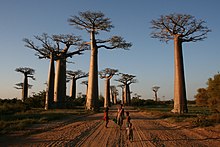Baobab avenue
The Baobaballee ( French Allée des baobabs , English Avenue of the baobabs ), rarely baobab avenue , is a prominent group of baobab trees on the dirt road from Morondava to Belo sur Tsiribihina in the region Menabe in western Madagascar . The unusual landscape attracts travelers from many countries, making it one of the main attractions in the region.
Trees
Baobab avenue is a section of road about 260 m long, on which 20 to 25 baobab trees of the species Adansonia grandidieri are each about 30 m high . About 20 to 25 other specimens of this species grow in nearby rice fields and meadows.
The baobab trees, which are up to 800 years old and are called renala ( Malagasy , German: "Mother of the Forest") by the locals , are a remnant of the tropical rainforests that once existed in Madagascar. The trees were originally not isolated in the bush landscape, but were surrounded by dense forest. Over the years the other trees were felled to create fields for agriculture, while the baobabs were spared by the locals out of respect, also because they are a good source of food and building materials.
About seven kilometers further north-west are two baobabs of the species Adansonia za , which are intertwined and are called Baobab Amoureux . According to legend, lovers met centuries ago and grew up together. It was turned into baobabs because the love of the young man and the young woman from the neighboring village could not be lived out, as both had already been promised to another spouse, so they had to marry independently in their respective villages. Nevertheless, the prevented couple dreamed of an infinite life together and of having a child together. They secretly asked a god for advice. The two baobabs were created and now live forever, as the couple had wished.
The baobab alley is the focus of local nature conservation activities. It was temporarily placed under nature protection by the Malagasy Ministry for the Environment, Water and Forests in 2007 as a first step on the way to becoming the first natural monument in Madagascar.
However, the area is not yet a national park. Therefore, the trees are endangered by the ongoing deforestation and by the sewage from nearby rice fields and cane sugar plantations as well as by the occasional bushfires and forest fires. Although the trees are popular as a tourist destination, there is no visitor center and no entrance fees, so local people earn little income from them. The non-profit organization Conservation International , in partnership with the local non-governmental organization Fanamby, has launched an ecotourism project, which aims to preserve the trees in the region and improve the economic situation of the local residents.
Web links
Individual evidence
- ^ Avenue of the Baobabs . Wondermondo.
- ↑ Helen Scales: The land of the giants Archived from the original on September 27, 2011. In: Geographical . No. March 2007.
- ↑ Baobab Amoureux - Baobabs in Love . Wondermondo.
- ↑ Allée des Baobabs: Un site classé aire protégée (fr) , Madagascar Tribune . August 1, 2007. Retrieved March 22, 2008.
- ↑ Madagascar's baobab avenue gains monumental status , German press agency. August 14, 2007. Archived from the original on February 26, 2008. Retrieved on March 22, 2008.
- ^ Nicole Johnston: Baobab band-aid , Mail & Guardian Online. August 15, 2007. Archived from the original on October 6, 2007. Retrieved March 22, 2008.
Coordinates: 20 ° 15 ′ 3 ″ S , 44 ° 25 ′ 6 ″ O


